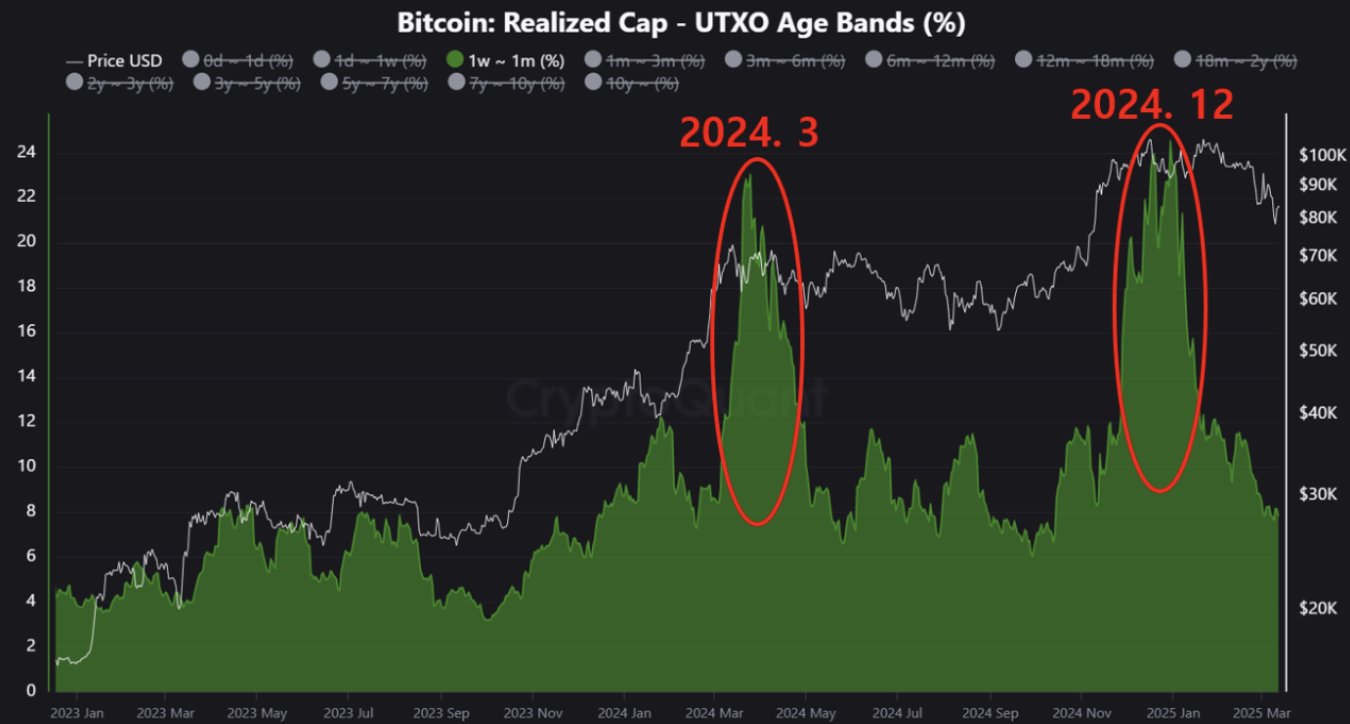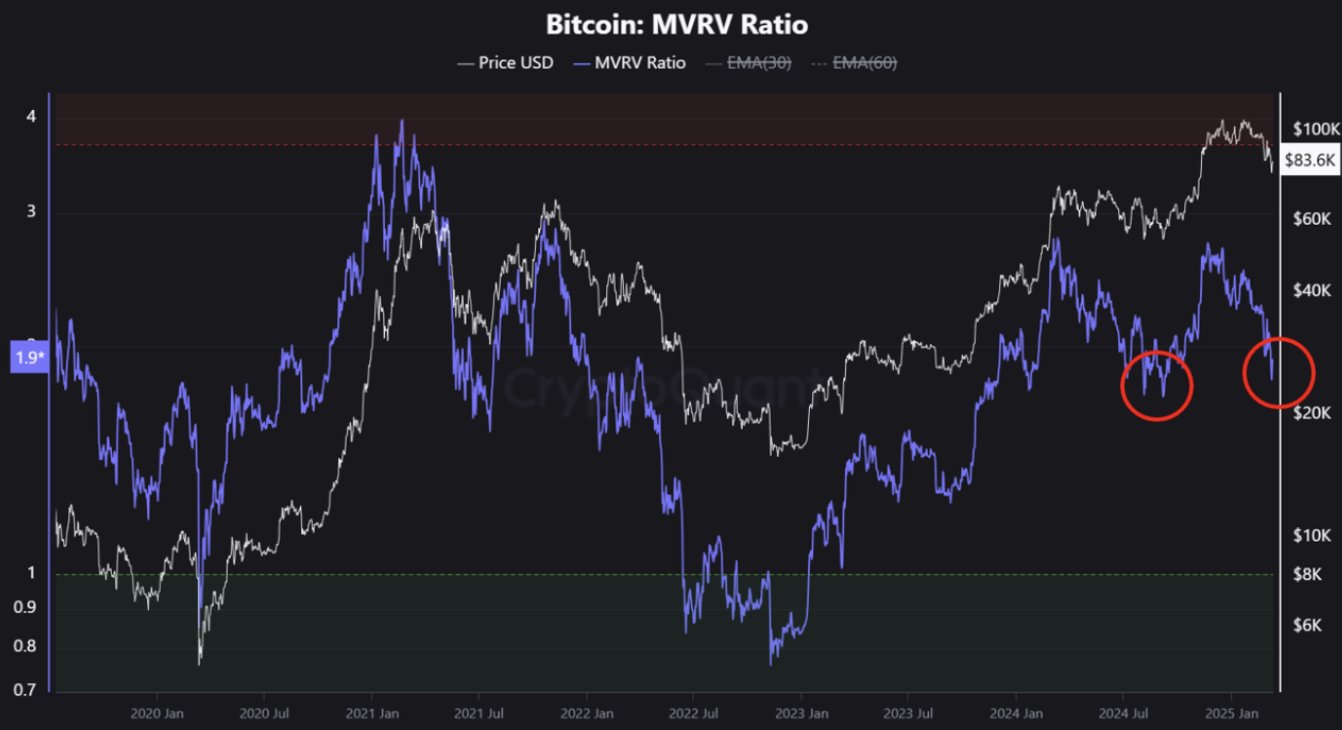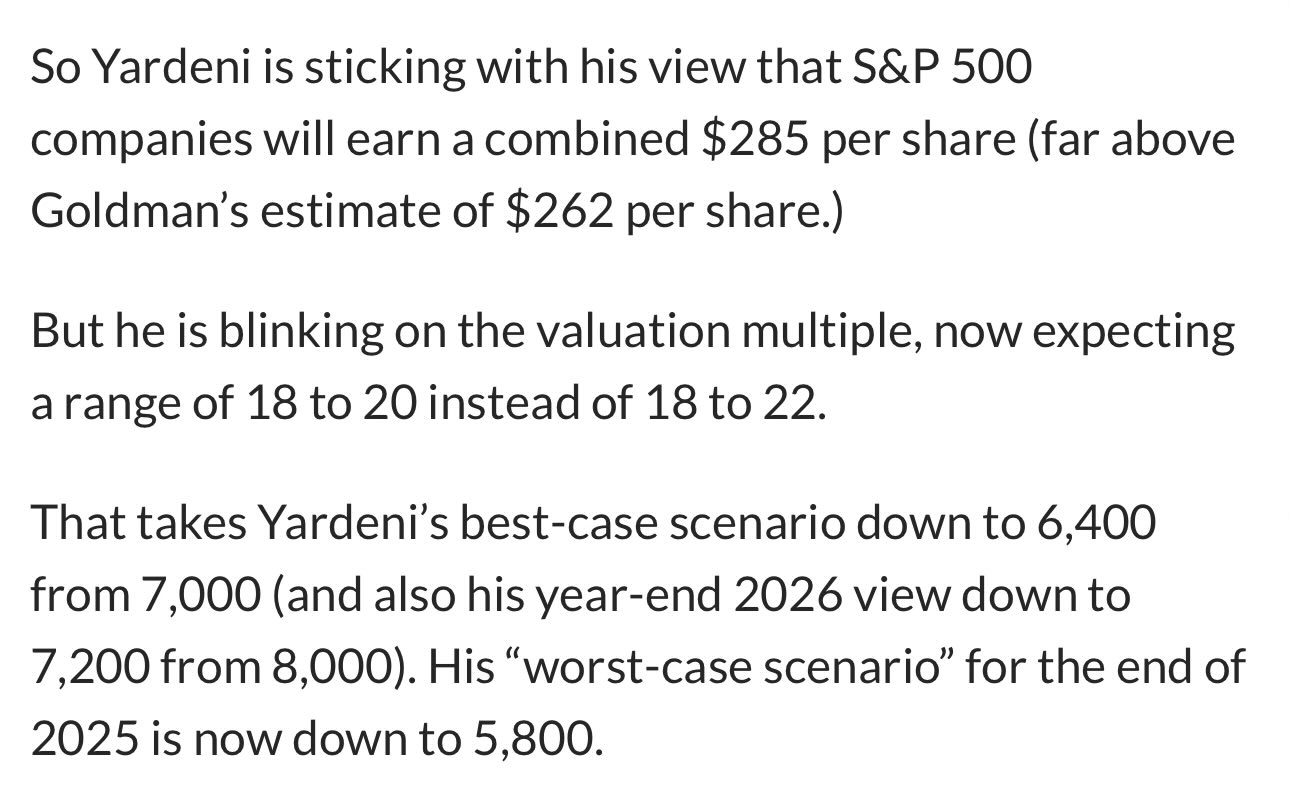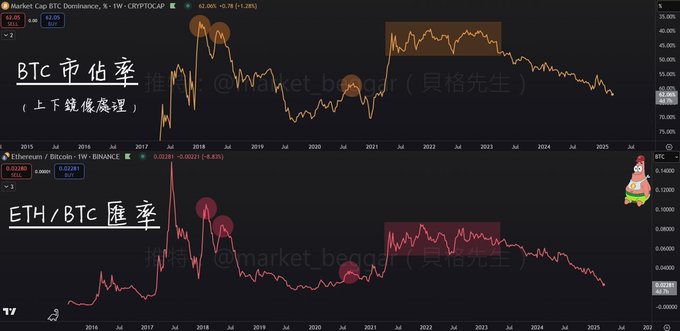As of March 13, 2025, Bitcoin (BTC) has fallen 3% in the past 24 hours, with the current price at $81,148 and the Bitcoin market dominance (BTC.D) falling to 61.68%. Market sentiment is gloomy, with the trading volume of centralized exchanges shrinking 21% to $72 trillion last month, and Wall Street anxious due to the "Trump selloff". Meanwhile, technical indicators show an "oversold" state, the derivatives market remains resilient, and signs of recovery in Bitcoin ETF inflows are emerging. In this complex situation, is Bitcoin undergoing a normal adjustment within a bull market cycle, or is it sliding into a deeper bear market? Based on the latest data and multiple perspectives, this article will systematically analyze the current market and outlook from three dimensions: short-term volatility, potential risks, and long-term opportunities.
I. Short-term Volatility: The Logic and Support of Bull Market Adjustments
Normal Correction within a Bull Market Cycle
Bitfinex analysts point out that price adjustments within a bull market cycle are a typical phenomenon, and the current decline may only be a temporary fluctuation, not the beginning of a long-term bear market. They emphasize that Bitcoin's performance is closely related to the broader financial market, especially the performance of stocks and bond yields. If global liquidity conditions ease and institutional capital inflows continue, the $72,000-$75,000 support level could become the foundation for a rebound. On March 12, Bitcoin ETF net inflows broke the trend of consecutive five-day outflows, with ARK Invest's ETF performing particularly strongly, indicating that institutional demand has not waned due to short-term volatility. Analysts believe this may be a signal that fund managers are realigning their positions in anticipation of a dovish shift in Federal Reserve policy.

Cointelegraph cites analyst Marcel Pechman's view to further corroborate this assessment. He believes that due to the stability of the derivatives market, the weakness of the US dollar, and the US budget crisis, Bitcoin's current correction may be nearing its end. On March 11, Bitcoin fell to a four-month low of $76,700, while the S&P 500 index fell 6% in a week, as investors' concerns about a global economic recession intensified. However, compared to the bear market collapse in late 2021 (from $69,000 to $40,560, taking 60 days), this adjustment is more akin to the mid-term correction in June 2024 (from $71,940 to $49,220, a 31.5% decline). A 30% correction is not uncommon in Bitcoin's history and has not triggered systemic panic.
Technical Indicators and the Resilience of the Derivatives Market
Technical analysis shows positive signals. CryptoQuant analysts say the market has entered the "oversold" zone, and selling pressure has been fully released, which could provide favorable conditions for an upswing, even without further severe declines. Additionally, the Bitcoin derivatives market has shown resilience. Pechman points out that despite the price drop, the futures annualized premium remains at 4.5%, far above the sub-0% level seen after the June 2022 collapse. The perpetual futures funding rate is close to zero, indicating a balanced demand between longs and shorts, unlike the bear market scenario where shorts dominate. This contrasts sharply with the situation in late 2021, when a strengthening US dollar (DXY rising from 92.4 to 96.0) accompanied investors' shift to cash positions, while currently, the DXY has fallen from 109.2 at the beginning of the year to 104, reducing the appeal of safe-haven assets.


II. Potential Risks: Macroeconomic Pressures and Extreme Scenarios
Macroeconomic Uncertainties
Although short-term indicators are optimistic, the uncertainties in the macroeconomy cast a shadow over the market. Yardeni Research president Ed Yardeni, a Wall Street "bull" who once predicted the S&P 500 index would reach 7,000 points, has recently taken a more cautious stance. He warned that a "bear market may have already begun" and pointed out that "Trump tariffs 2.0" could trigger a flash crash similar to 1962 or 1987. Mars Finance also reports that Wall Street is uneasy due to the "Trump selloff", with the "buy the dips" strategy that has dominated the market for the past 20 years being replaced by "locking in profits" and "waiting and seeing". Roundhill Investments CEO Dave Mazza describes the current buy-in as akin to "buying discounted tickets to an unknown performance", full of high risk and uncertainty.

Robert W Baird & Co. managing director Ted Mortonson says the market has entered "preservation mode", especially in the tech and crypto sectors, facing the typical cyclical headwinds in the spring. The 21% decline in centralized exchange trading volume to $72 trillion further reflects liquidity pressures. If global recession expectations materialize or trade wars escalate, the crypto market may face greater shocks.
Risks of Losing Key Support Levels
Although CryptoQuant views the "oversold" condition as a buying opportunity, if investor sentiment turns to extreme panic, technical rebounds may be suppressed. Historical data shows that panic selling often accompanies liquidity crises and confidence collapses. If Bitcoin breaks below $74,000 and triggers a chain reaction, the short-term volatility could evolve into a longer-term bear market. Bitfinex's optimistic forecast depends on the improvement of global liquidity, but if this premise is not realized, the risks will be significantly amplified.
Eugene Ng Ah Sio presents more specific downside scenarios from a technical perspective. He predicts that if MicroStrategy conducts a large-scale selloff, Bitcoin could fall to $52,000 or even $25,000, representing declines of 36% and 70%, respectively. For Solana (SOL), he believes $80 is a critical support level, and a breach could lead to a plunge to $25, a drop of over 80%. While these extreme bottom levels are low-probability events, they are not impossible under a deteriorating macroeconomic environment, such as institutional capital withdrawal or liquidity depletion. The $25,000 hypothesis, though startling, is still within a reasonable range compared to the 2022 bear market low of $16,000.
The Misconception of BTC.D and the Impact of ETH
BTC.D (Bitcoin's market dominance) is often misinterpreted as a market barometer. The current BTC.D decline to 61.68% has led some to anticipate the start of an "Altcoin season". However, a drop in BTC.D is usually the result of "BTC's rally slowing + Altcoins rising", rather than the cause. Its performance is largely driven by Ethereum (ETH) and highly correlated with the ETH/BTC exchange rate. Eugene has removed ETH from his portfolio, indicating caution about ETH's short-term prospects, which could further weigh on BTC.D, but not necessarily signal an Altcoin boom. Investors who rely solely on BTC.D to judge trends may overlook ETH's dominant role and the market's true dynamics.

III. Long-term Opportunities: Policy Shifts and Market Potential
US Policy Shift: From Regulatory Hostility to Strategic Reserves
The US government's attitude towards digital assets is undergoing a historic transformation, injecting new momentum into Bitcoin's long-term prospects. On March 7, President Trump signed an executive order formally establishing a "Strategic Bitcoin Reserve" and a "Digital Asset Stockpile", marking the first time the US has viewed Bitcoin as a strategic asset, akin to traditional reserves like gold. White House officials have dubbed it the "Fort Knox of the digital age", emphasizing Bitcoin's scarcity and security, and believe its fixed supply (21 million) gives it strategic value. The executive order stipulates that the Bitcoin in the reserve will come from criminal and civil asset forfeitures and will not be sold, intended as a long-term store of value. This policy reversal overturns the Biden administration's regulatory hostility towards the crypto industry, reflecting Trump's determination to fulfill his campaign promise to make the US a "crypto capital".
On March 11, Senator Cynthia Lummis (R-WY) reintroduced the BITCOIN Act, proposing that the U.S. government purchase 1 million Bitcoins (about $80 billion at current prices) over the next 5 years, and codifying Trump's Bitcoin reserve plan into law. The bill will also raise funds through the Federal Reserve's net earnings and the issuance of new gold certificates by the Treasury Department (based on current market prices). Lummis stated that this bill aims to "leverage the full potential of digital innovation, address the national debt problem, while maintaining a competitive edge in the global economy." This legislative move indicates that the U.S. may further expand its Bitcoin holdings, consolidating its leading position in the global digital asset race.
Macro Liquidity Easing: A Potential Catalyst for Central Banks
The improvement in macro liquidity may be another major driver for the long-term rise of Bitcoin. Arthur Hayes posted on the X platform that the current market adjustment is a normal phenomenon in the bull market, and he predicted that Bitcoin may bottom out around $70,000, a 36% drop from the all-time high of $110,000, which is not uncommon in the bull market cycle. He further pointed out that the stock market (especially the S&P 500 index SPX and the Nasdaq index NDX) may enter a "free fall" stage, triggering further slowdown in the global economy. However, this pressure may prompt major central banks to take action. Hayes expects the Federal Reserve, the European Central Bank, and the Bank of Japan to successively implement loose policies to stimulate their respective economic recoveries.
Hayes' analysis provides a macro perspective on the long-term potential of Bitcoin. The implementation of loose policies usually means interest rate cuts, asset purchases, or quantitative easing, which will increase market liquidity, lower the risk-free interest rate, and thus drive up the prices of risky assets. As an anti-inflationary asset, Bitcoin often performs strongly in a liquidity-easing environment. For example, the Federal Reserve's ultra-loose policy in 2020-2021 drove Bitcoin to surge from $10,000 to a historic high of $69,000. Hayes suggests that investors "go all in" at this stage, although they may miss the absolute bottom, but can avoid long-term volatility and potential unrealized losses. For more cautious investors, he recommends waiting for the loose policies of major central banks to be implemented before increasing capital investment to reduce risk.
Accelerated Institutionalization: The Fusion of Banks and Blockchain
The U.S. policy shift is not limited to government reserves, but may also drive a broader institutionalization process. On March 12, Forbes published an article stating that digital assets have moved from the periphery to the core of the financial system, and traditional banks are increasingly interested in the crypto market. The article proposes that U.S. banks should be allowed to hold mature digital assets such as Bitcoin and Ethereum, and manage risks through diversification, hedging strategies, and strict exposure limits. Banks have already dealt with volatility in the foreign exchange and commodity markets, and similar tools are fully applicable to crypto assets. In addition, blockchain technology can optimize cross-border payments, reduce transaction costs, and drive financial institutions towards true 24/7 operations. This modernization potential may attract more banks to enter the market, further enhancing the market legitimacy and liquidity of Bitcoin.
The White House's first Crypto Summit on March 7 also sent positive signals. Trump expressed support at the summit for Congress to pass legislation on stablecoins and the crypto market, calling it a "tremendous opportunity for economic growth and financial innovation." Attendees included industry leaders such as Michael Saylor of MicroStrategy and Brian Armstrong of Coinbase, indicating the government's willingness to cooperate with the crypto industry. Coinbase CEO Brian Armstrong stated that "the U.S. government is now a holder of Bitcoin, and may even be a buyer, which will prompt other G20 countries to view Bitcoin as the successor to the gold standard." This trend may trigger a "Bitcoin reserve race" globally, further boosting its long-term value.
IV. Conclusion and Investment Recommendations
For investors, the current situation is both a challenge and an opportunity. Before the trend is clear, maintaining flexibility is wiser than blind bottom-fishing or selling. Short-term traders can focus on the support level of $74,000-$76,000, and judge the timing of the rebound based on ETF fund flows and the DXY trend. Long-term investors should focus on policy developments and institutional behavior, and avoid being distracted by short-term volatility. As Ed Yardeni said, a bear market may be quietly approaching, but the confidence of Bitfinex and the resilience of the derivatives market are also reminding us that the story of the bull market may not be over yet.
Bitcoin's next step depends on the direction of the global economic chessboard. At the crossroads of gloom and hope, caution and patience may be the best choices for now.








